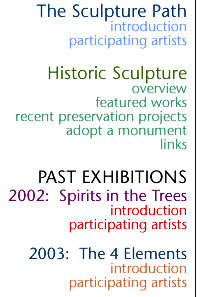![]()
 
|
The
4 Elements: Earth, Air, Water and Fire A
checkered picnic blanket made of grass... During the summer of 2003, visitors to historic Forest Hills Cemetery encountered an adventurous exhibition of site specific installation and sculpture exploring the age-old theme of the four elements. An ancient formula, drawn from Greek philosophy and medieval alchemy, is given a new spin by 20 artists working in diverse materials. The exhibition – at times striking and at times subtle – wound through the landscape of historic Forest Hills Cemetery. A festive opening reception was held on June 22 from 3 to 6 pm. The exhibition ran from June 15 through October 31 and was free to the public. Four
of the works created for The 4 Elements will remain on display through
October 31, 2004. They are:
Exhibition
Description The theme of the four elements put the focus on materials, and the participating artists were inventive in their representations of earth, air, water and fire. They used both natural and manmade materials – sod, cement, rubber, gathered branches, pine needles, mechanical devices – in unusual combinations and juxtapositions which explored the interplay of nature and artifice, paradox and transformation. The Trust convened an accomplished jury to review 170 design proposals received in the spring of 2003:
The jury selected 20 selected artists to create 17 installations; several worked in collaborative teams. The Trust’s director, Cecily Miller, worked with each artist to site the pieces on the 275-acre grounds. “One of the goals of the exhibition” explains Miller “is to engage visitors in active exploration and discovery. The route invites people into some beautiful, almost secret, areas of Forest Hills as well as its grand formal spaces, so rich with art and architecture. It’s a fascinating environment for contemporary art, it’s so fraught with meaning and history.” The
artists were largely from New England, although Oregon and Virginia were
also represented. Artists Frank Vasello, Thomas Matsuda,
Larissa Brown, Jeanne Drevas, and Jeffrey Hayes created
sculptural forms from natural materials ranging from gathered branches
and pine needles to imported water hyacinths. The team of Daniel Bouthot
and Christopher Ho, and landscape architects Kaki Martin and
collaborators Susan Child and Chris Alonso inscribed their designs
directly into the earth by planting patterned sod, rosemary beds, and
a long line of lime mixed with rye seed designed to illuminate the varied
topography of the cemetery. The
4 Elements was made possible through grants from the Boston Foundation,
the John H. and H. Naomi Tomfohrde Foundation and an anonymous funder. Directions and a complete calendar of events are available on this site, or call 617.524.0128.
|
[FHET
HOME] [ABOUT FOREST HILLS] [EXHIBITIONS
& SCULPTURE] [CALENDAR OF EVENTS]
[EDUCATION & PRESERVATION] [CONTACT
US] [DIRECTIONS & HOURS]